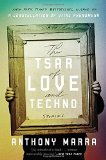Summary | Excerpt | Reviews | Beyond the Book | Read-Alikes | Genres & Themes | Author Bio

Stories
by Anthony MarraThis article relates to The Tsar of Love and Techno
A fictional nineteenth-century pastoral painting by real-life Chechen painter, Pyotr Zakharov-Chechenets, features in one of the stories in The Tsar of Love and Techno.
Pyotr Zakharov-Chechenets was born in 1816 during the Caucasian War, which was the subject of historical fiction from Tolstoy, Lermontov, and Pushkin. In 1819 the three-year-old was found beside his dead mother and nursed back to health by Zakhar Nedonosov, from whom he received his surname. The term "Chechenets" was then appended to his last name to show his ethnic identity. When he was seven years old the boy was adopted by Major-General Pyotr Yermolov, who raised him alongside his seven children.
 Zakharov showed early talent for painting but was initially rejected by the Imperial Academy of Arts in St. Petersburg, and so he received private lessons from the portraitist Lev Volkov instead. At age 17 he was finally accepted to the Academy, from which he graduated with a diploma in 1835. His status as an ethnic minority counted against him in the distribution of travel scholarships; he never got the chance to study in Italy as he had hoped to.
Zakharov showed early talent for painting but was initially rejected by the Imperial Academy of Arts in St. Petersburg, and so he received private lessons from the portraitist Lev Volkov instead. At age 17 he was finally accepted to the Academy, from which he graduated with a diploma in 1835. His status as an ethnic minority counted against him in the distribution of travel scholarships; he never got the chance to study in Italy as he had hoped to.
Over the course of his short career, Zakharov earned acclaim for his portraits completed on commission. Many of these are held by Moscow's Tretyakov Gallery and the Russian Museum in St. Petersburg. The Grozny Art Museum in Chechnya also displayed many of his works including a self-portrait and Portrait of I. F. Ladygensky, but when the museum suffered artillery fire in 1995 during the First Chechen War, the paintings were severely damaged. They have been undergoing repair at Grabar Restoration Center in Moscow.
 During his lifetime Zakharov struggled for money despite portrait commissions and had to change his lodgings often. In 1840 he was hired by the Military Ministry, where he made over 60 drawings of the different weapons and uniforms in use in the Russian army. He settled in Moscow for his health in 1842 – the climate was considered more sanitary than St. Petersburg's. Alas, his wife died of tuberculosis just five months after their marriage in 1846, and a few months later he died of the same cause, at the age of 30.
During his lifetime Zakharov struggled for money despite portrait commissions and had to change his lodgings often. In 1840 he was hired by the Military Ministry, where he made over 60 drawings of the different weapons and uniforms in use in the Russian army. He settled in Moscow for his health in 1842 – the climate was considered more sanitary than St. Petersburg's. Alas, his wife died of tuberculosis just five months after their marriage in 1846, and a few months later he died of the same cause, at the age of 30.
In The Tsar of Love and Techno, Marra uses one of Zakharov's paintings, Empty Pasture in Afternoon – which appears to be fictional – as a recurring artifact linking characters across decades. Ruslan wrote his dissertation about Zakharov and celebrates him as a "Chechen who learned to succeed by the rules of his conquerors, a man...to be admired and pitied." Here Ruslan describes Empty Pasture in Afternoon: "A meadow, an apricot tree, a stone wall in a diagonal meander through the grasses, the pasture cresting into a hill, a boarded well, a house….It's among the least ambitious of all Zakharov's work" yet holds great significance for Ruslan and the other characters who encounter the painting and the field it represents.
Picture of Zakharov, a self-portrait, from Wikimedia Commons
Picture of children's portrait, also painted by Zakharov, from The Tretyakov Gallery
Filed under Music and the Arts
![]() This "beyond the book article" relates to The Tsar of Love and Techno. It originally ran in November 2015 and has been updated for the
July 2016 paperback edition.
Go to magazine.
This "beyond the book article" relates to The Tsar of Love and Techno. It originally ran in November 2015 and has been updated for the
July 2016 paperback edition.
Go to magazine.
Your guide toexceptional books
BookBrowse seeks out and recommends the best in contemporary fiction and nonfiction—books that not only engage and entertain but also deepen our understanding of ourselves and the world around us.